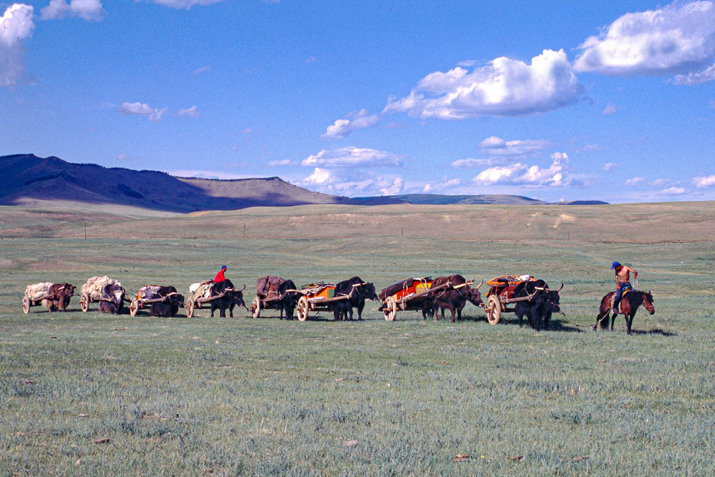
Were the planned daily stages a miscalculation?
N 49°46'453'' E 100°09'689''
Day: 89
Sunrise:
07:49
Sunset:
18:28
As the crow flies:
9,19
Daily kilometers:
14
Total kilometers:
801
Soil condition:
Gravel/meadow
Temperature – Day (maximum):
5°C
Temperature – day (minimum):
minus 4°C
Temperature – Night:
minus 14°
Latitude:
49°46’453”
Longitude:
100°09’689”
Maximum height:
1850 m above sea level
Time of departure:
12:30
Arrival time:
17:00
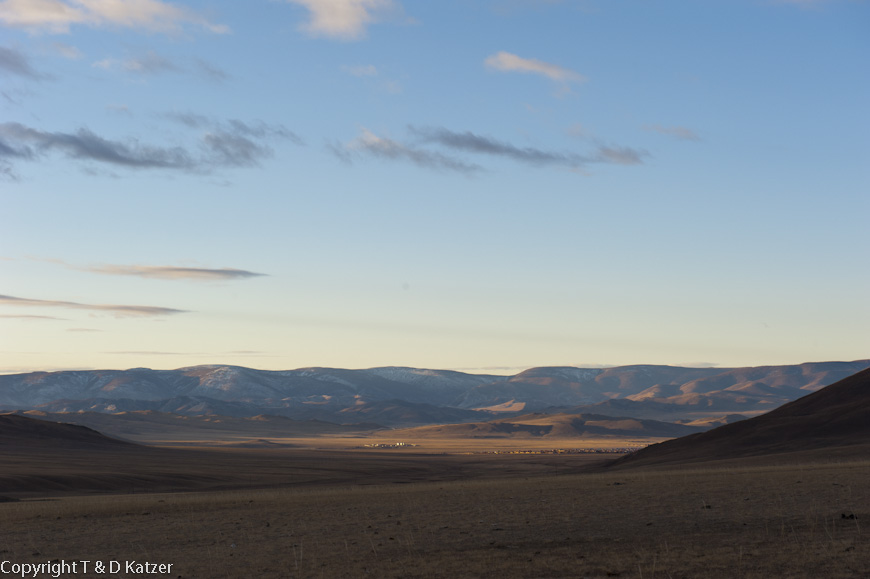
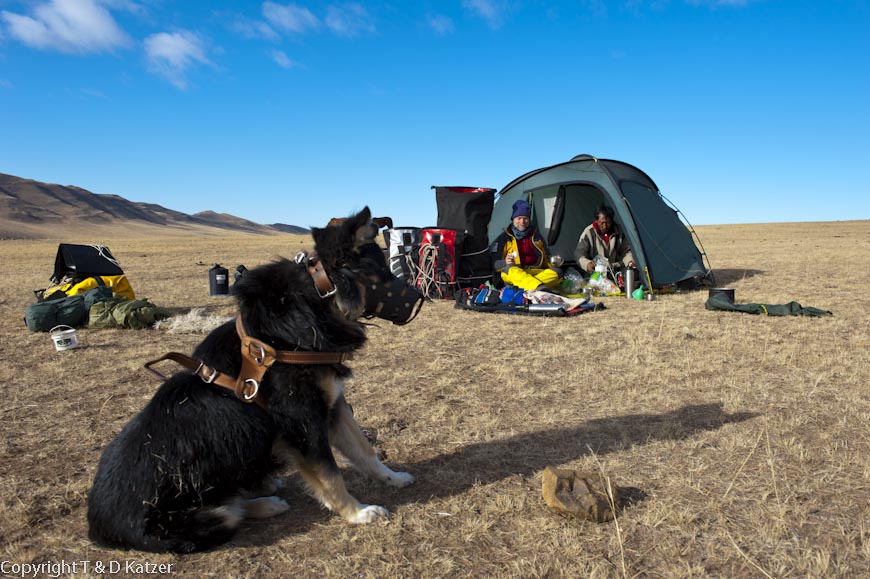
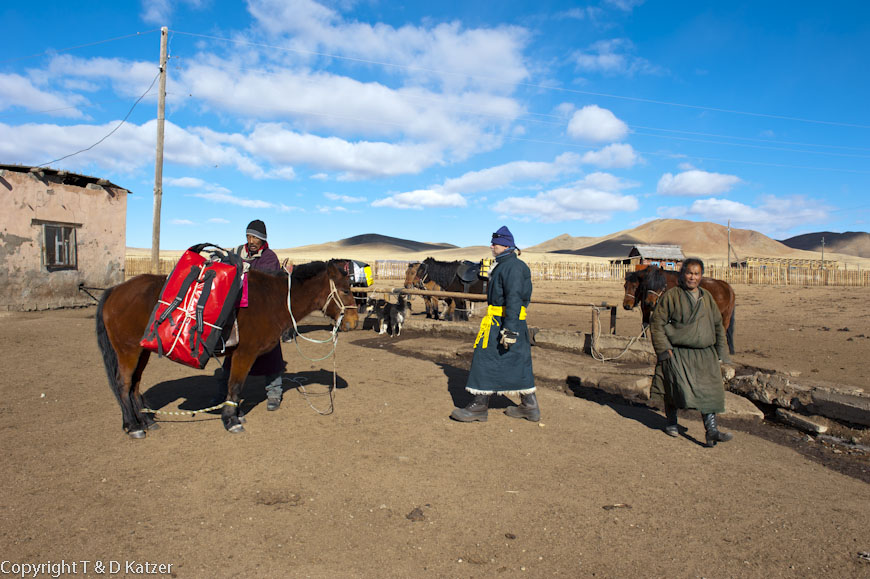
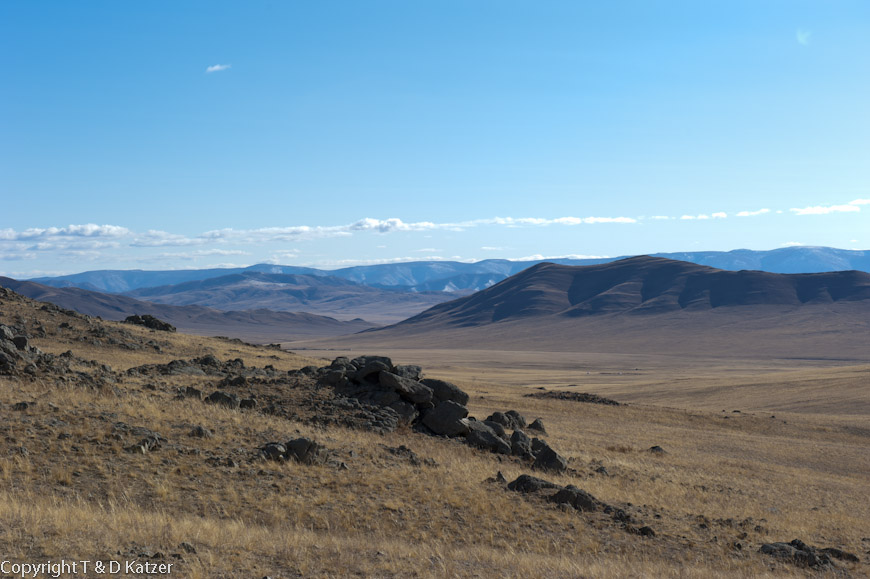

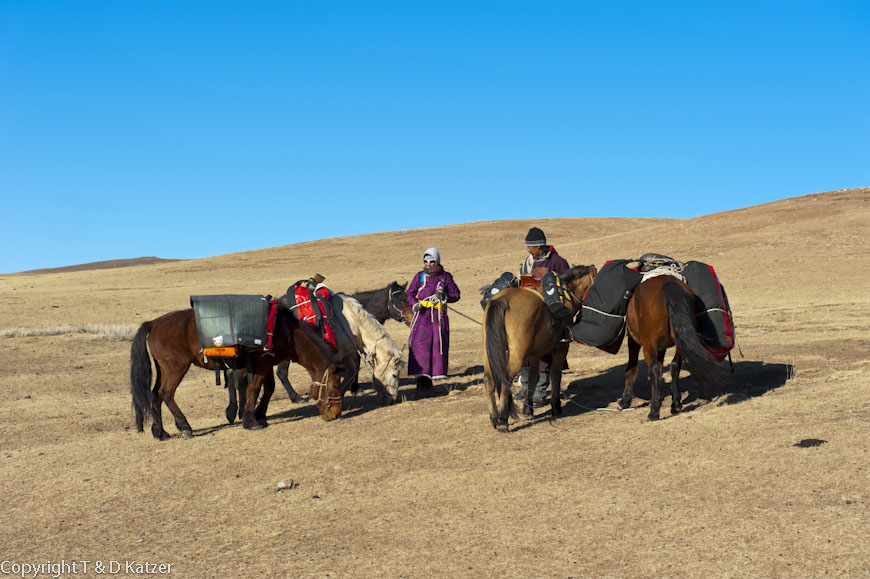
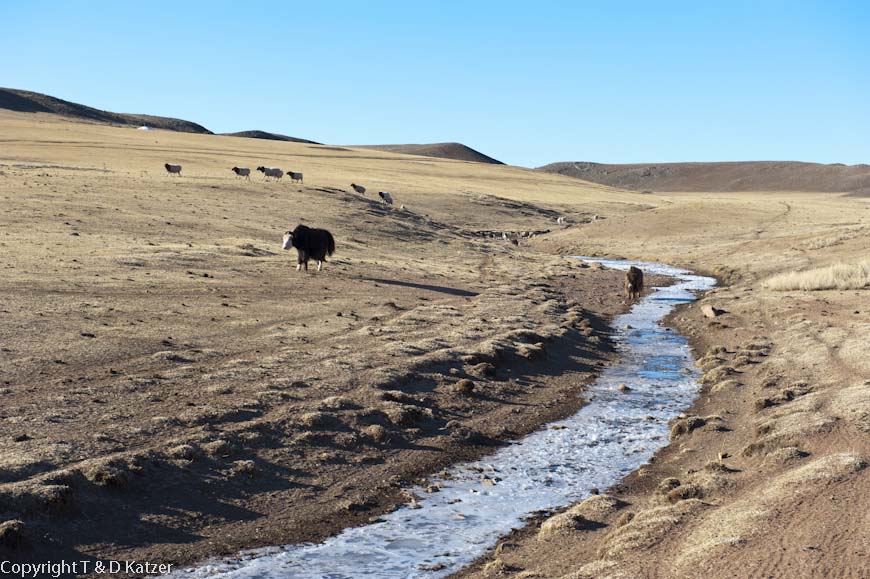


This morning we are woken up by a radiant flood of light. My thermometer shows minus 4° in the sun. As we have been living in a relatively comfortable yurt for the last few weeks, which has softened our bodies, the young day feels surprisingly cold. I immediately put on a pair of thermal pants over my two pairs of underpants and the windstopper trousers. Then I clear out our overnight accommodation again. As we leave the tent, the brown, grazed mountain slopes stretch out before us, with the houses of the town of Mörön huddled together in the valley. The landscape doesn’t look so spectacular in daylight. Compared to last night, she seems to have put on a cloak of peace. Bilgee stands on a nearby hilltop to talk to his children and relatives on the phone. He reports on our successful start. When he returns, we put a pot of the water we brought with us on the Chinese stove. Because the gas cartridge barely provides enough gas for flames, Bilgee is forced to turn it constantly. “Muu” (“Bad”) he says, pointing at the thing and holding up the little finger of his right hand in affirmation. “Sure, how could it be otherwise. It’s made in China,” I reply. It takes an eternity and almost an entire cartridge for the water to boil in the pot. Sitting in front of Bilgee’s vestibule, we drink hot tea and eat Mongolian pastries. With his muzzle on, Mogi sits unhappily beside him. “It looks like he’s finally accepting the thing,” I say, pointing at our dog. “I hope so. I’m not in the mood for any more drama,” Tanja replies. “I think it will be fine. With the muzzle, he won’t be able to bite any sheep or goats in the ass,” I reply with satisfaction.
We don’t pack up our camp until 10:30 am. Because we are now traveling with pack horses, everything takes much longer. It was already a strenuous procedure with the horse-drawn cart, but now that we have to stow everything on horseback, it’s a real job. It takes us two hours to finally sit in the saddle. “12:30 and our horses haven’t even had anything to drink yet,” I say, glancing at the clock. “It will all work out,” says Tanja confidently. “I hope so. Otherwise we’ll arrive in the north as icicles.” “There’s a waterhole down there,” Bilgee points to a small village. When we set off, Mogi remains lying down. His muzzle seems to paralyze him again. The camp is barely two hundred meters behind us when he jumps after us, kicking wildly. Once again, he uses all his tricks to get rid of his biting inhibitors. We know the order by now. I watch anxiously as he performs the centrifugal trick, followed by the meadow plow and finally the toe dragger. It only takes a few moments and the muzzle is hanging on his chest. “He’s done it again!” I call after Tanja. “And what do we do now?” she asks, reining in her horse. “Let it go. I’ll be fine,” I reply. The words have barely left my mouth when we spot goats in front of us. Mogi too. Then everything happens in a fraction of a second. Mogi storms towards the herd like a rocket launched from the launch pad. Our hearts immediately skip a beat when he reaches the excited animals and splits them up like an arrow. “Bilgee quickly! After him!” Tanja calls out, taking the reins from Od’s hand so that he is free. Bilgee does not react at first. “Quick Bilgee!”, she calls to him again, whereupon Bilgee finally gallops off far too late. In the meantime, Mogi has separated two young billy goats from the herd. Long before Bilgee reaches the scene, the animals stand back to back and parry every attack by our dog in this intelligent way that goats cannot be trusted with. Again and again, Mogi attacks only to shrink back from the grass-eaters’ horns, which are tilted towards the ground. In the meantime, Bilgee has also joined the action and drives Mogi away with angry shouts. “Phew, it ended well this time. If they had run away, he would have pulled them down again,” I realize and am relieved about Mogi’s failure. Tanja immediately puts him back on the leash. “I guess we can forget the muzzle,” she says, annoyed at having to keep the dog on a lead all the time again.
We reach the waterhole without further incident. As I try to get out of the saddle with my much too heavy Deel and the camera strapped around my chest, I get caught in the stirrup with my left monster shoe. As if staggering, struggling for balance, I stagger down. It’s only by outrageous luck that I don’t end up backwards in the concrete animal trough. “Uff, lucky me,” I snort and help Bilgee water the horses. Then we tighten the cords with which we have tied our luggage to the horses’ backs. Bilgee asks a Mongol, who has also brought his mount here to drink, for directions. Always in this direction. Then you have to ask again,” he explains.
We are only ready to continue riding at 2 pm. We are making very slow progress. Far too slow to cover the necessary distance. “We should trot. Are you ready?” asks Bilgee. “Sure,” we reply. “Choo! Choo! Choo-choo!” we urge the horses on. It takes us a considerable amount of effort to get the animals going. Bilgee rides ahead, pulling the stubborn Od behind him. I follow him with Sharga and Bor, who lets himself be pulled along. Then Tanja arrives with Mogi. Now that Mogi is back on the leash and is constantly pulling on the leash due to his constant rushing ahead, Tanja is just as busy as if she had a horse in tow. Because of my two packhorses it is not possible for me to take photos. Filming is definitely out of the question. The effort of reining Sar in, plopping out of the saddle with my heavy Deel and big shoes, getting one foot on the horses’ three guard ropes so they don’t run off with our vital equipment and food, all just to take a picture, is out of all proportion to the effort. And yet the landscape we ride through is so spectacular that I keep asking myself how I manage to keep up the photo documentation of this fantastic journey? “We’re taking a shortcut. See those mountains up ahead. We’ll ride over them,” Bilgee decides. It goes higher and higher. With our horse-drawn carriage, we would have been forced to turn back a long time ago. “It’s amazing what a horse can do!” Tanja calls out to me. “Yes, I feel like I’m sitting on a chamois,” I laugh, steering my animals through the rocks.
On the hilltop, in the middle of absolute solitude, we meet a man watching his flock of sheep with his small telescope. We ride up to him to ask for a place to camp where our horses can find something to eat and water. The shepherd wears a lined deel, warm fur-lined shoes and a woolly hat. He kindly explains that he can find us a suitable place in the valley. “I’ll show you where to go,” he tells Bilgee and swings himself into the saddle of his moped, which is only a few meters below the hilltop. The moped or small motorcycle has also made inroads in this region and is increasingly replacing the riding horse. The man rattles down from his panoramic mountain into the valley on a two-wheeler made in China (where else). So that our horses don’t fall, we follow him on a serpentine route. Once we reach the bottom, we ride next to a watercourse which is completely frozen over the higher we get. Yaks and sheep gather at some of the holes in the ice to quench their thirst with the cold liquid. The route continues upwards along the stream. “The sun will disappear in 1 ½ hours. Then it will be unpleasantly cold. We should stay here somewhere,” I try to make myself understood. “Tijm” (“Yes”), Bilgee replies thoughtfully, scanning the area for grass with his binoculars. The shepherd from the mountain darts along the shady side of a mountain slope about a kilometer away. Then he changes direction and comes towards us. “There, on the mountainside, there is enough grass for your horses,” he reports. Even though I would much rather have set up camp on the other side of the valley because of the warming rays of sunshine, we ride with the friendly nomad. “He’ll already know where the best grazing ground is here,” says Tanja. “Definitely. But the firewood doesn’t look very good,” I reply, wondering how we’re going to heat our water with the terrible gas.
It’s 5 p.m. and at minus 12 degrees it’s the coldest day so far when we reach our camp site, dog-tired. I get off the horse with difficulty, concentrating on not getting caught in the stirrups and not falling. We unload our horses in the remaining sunlight. As soon as we have unloaded, the golden beams of energy from the distant star disappear behind the mountain peak. Voracious shadows grow in size and strength. They eat their way across the land at considerable speed and touch us with their icy fingers. The motorcycle shepherd and Bilgee disappear for quite some time. They want to get something, Bilgee said. It doesn’t take long for our helpful host and Bilgee to bring what we need most out here. Wood and water. Our tents are quickly erected. In the meantime, Bilgee has lit the fire and Tanja has put a pot of water on it. Bilgee has a little chat with the helpful shepherd. He explains in which direction we have to ride tomorrow and where the next river is supposed to be. As always on this expedition, water is responsible for how far the daily stages are. Sometimes it’s only 10 km. Sometimes 30 km or more.
We sit around the small fire and warm our hands. My back hurts. The reason for this is the heavy duffel bags that we have to load onto the horses. A vague, rather unpleasant feeling creeps up inside me, slowly but as tangibly as an iron fist. I’m afraid of getting a slipped disc out here. “What happened during our cycle tour in Romania won’t happen again. You have a healthy back, Denis,” Tanja’s words reassure me. “It takes a long time to forget the nightmarish pain I had back then. But you’re right. It won’t happen again. It’s just my psyche that takes on a life of its own from time to time,” I reply thoughtfully. “How far have we actually come today?” Tanja Bilgee wants to know. I take the GPS out of my pocket, press a few buttons and read the sobering figure of 9.19 km. “Only 9 km?” wonders Tanja. “As the crow flies. That means we rode about 15 km,” I explain. “Not exactly reassuring,” she replies. “How many kilometers do we have to cover in a day according to our schedule?” she wants to know. “Hm, we had planned 30 to 40 km a day. But with the difficult terrain, the search for good grazing grounds, firewood and the effort involved in loading, these distances could have been a huge miscalculation. We will get as far as we can. There’s no point in worrying too much about it. We have to look at it as stoically as an ox turning the millstone. One step in front of the other. Then we’ll make it before there’s another massive cold snap,’ I say confidently, hoping I’m not wrong.
It is pitch dark as we retreat into the tent to survive the coldest night of our trip so far. It looks like the days of bringing my laptop up to working temperature with my bare body are definitely over. Tanja filled a small hot water bottle with boiling water for me. I’m now sitting in my sleeping bag at minus 14°, my laptop resting on the hot water bottle, which in turn is resting on my thighs. In this way, I am able to record the experiences of the day in short form during my shift today from midnight to 2:30 a.m. and label the pictures.
We look forward to your comments!

